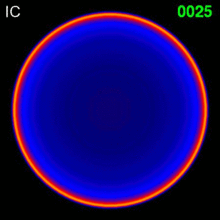Energetic ions and electrons in space are deflected by electromagnetic fields. In a homogenous magnetic
field that leads to helical motion, and fluctuations in the magnetic field can modify the pattern of that
motion, but will not change the energy of the particle.
Particle acceleration requires an electric field. We investigate three processes that involve electric
fields and lead to particle acceleration. At cosmic shocks, that are found in essentially all outflow sources, the systematic difference in flow
speed on the two sides of the shock leads to systematic acceleration that is akin to the acceleration of a
tennis ball bouncing off a moving racket.
Turbulence in space provides fluctuating electric fields that can accelerate particles in a statistical
manner, as some particles gain energy and some (fewer) lose energy. Often, this so-called stochastic
acceleration re-accelerate electrons and ions that received their first boost in energy through other
processes.
Magnetic reconnection destroys magnetic fields, but can lead to an electric field that efficiently
accelerates electrons and ions. This process is particularly effective, where the magnetic field is
initially strong, such as on the surface of the sun.

Loading menu, please wait..
Deutsches Elektronen-Synchrotron DESY
A Research Centre of the Helmholtz Association




